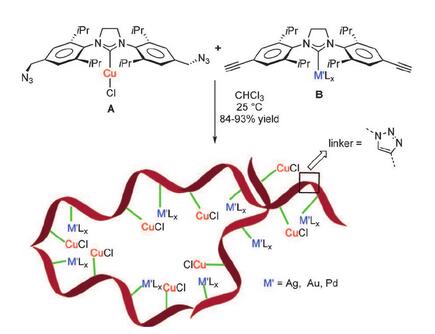Abstract: Heterobimetallic molecular complexes or strictly alternating metallated polymers are obtained by a click reaction between mononuclear metal complexes (secondary building units, SBUs) bearing NHCs functionalized with either p-azidophenyl or p-ethynylphenyl wingtips. With a copper-NHC complex as SBU the formation of molecular or polymeric compounds did not require any additives as the copper complex catalyzes the click reaction. Transmetallation from heterobimetallic Cu/Ag derivatives to Cu/Pd derivatives was achieved. The linker between the SBUs (flexible or rigid) influences the catalytic activity of the heterobimetallic compounds. The polymer with alternating copper-NHC and silver-NHC units and a flexible methylene-triazole bridge between them shows the highest activity in the catalytic alkynylation of trifluoromethyl ketones to give fluorinated propargylic alcohols.

KeyWords Plus: N-HETEROCYCLIC CARBENES; TRANSITION-METAL-COMPLEXES; POROUS ORGANIC POLYMERS; TRIFLUOROMETHYL KETONES; COOPERATIVE CATALYSIS; COORDINATION CHEMISTRY; TERMINAL ALKYNES; TANDEM CATALYSIS; CARBON-DIOXIDE; TRANSFORMATIONS
Published in ANGEWANDTE CHEMIE-INTERNATIONAL EDITION, 55 (27):7665-7670; 10.1002/anie.201600999 JUN 27 2016


